Faiq Mari
SPECIAL REPORT
Faiq Mari
Teaching and Research Assistant, Department of Architecture, Faculty of Engineering, Birzeit University, Palestine; BERKELEY PRIZE Associate Teaching Fellow, 2013-14
(Faiq Mari, 2013 BERKELEY PRIZE 2nd Place Essay winner, is at the start of his life in architecture and teaching. As a Teaching and Research Assistant, he is an active participant in helping to broaden his school's understanding of the goals and potentials of teaching the social art of architecture. Faiq's special perspective on the subject is demonstrated in the report below.)
Report from the 2014 Indian National Student Design Competition
I was given a wonderful chance to represent the BERKELEY PRIZE at the gathering and presentation for the 2014 National Student Design Competition (NSDC) held by the School of Planning and Architecture in Bhopal, India (SPA Bhopal). The competition, titled “Inclusive Design for Cultural Interface in Pilgrimage Sites,” focused on the application of Universal Design in the Indian context. My trip was a unique opportunity through which I got a fascinating glimpse of India and the magnificent work on socially responsible design done at the SPA.
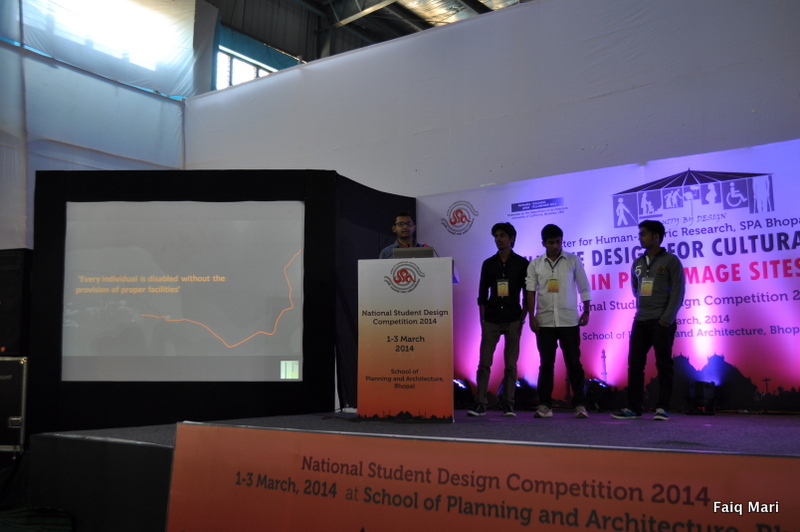 |
Participants presenting their project at the NSDC
|
During my first two days I partook in the competition, carefully contemplating the projects and listening to the feedback of the judging panel. I have seen a vast array of creative designs that handled their social and physical context exquisitely, and achieved inclusive environments for all users. More importantly I have witnessed great determination and belief in socially responsible design, and great knowledge being transferred. Moreover, it was a great chance to learn about the diverse Indian context, pilgrimage sites being an epitome of its diversity. Particularly educative was studying the means through which architects and architecture students dealt with the notion of ‘universality’ in this context.
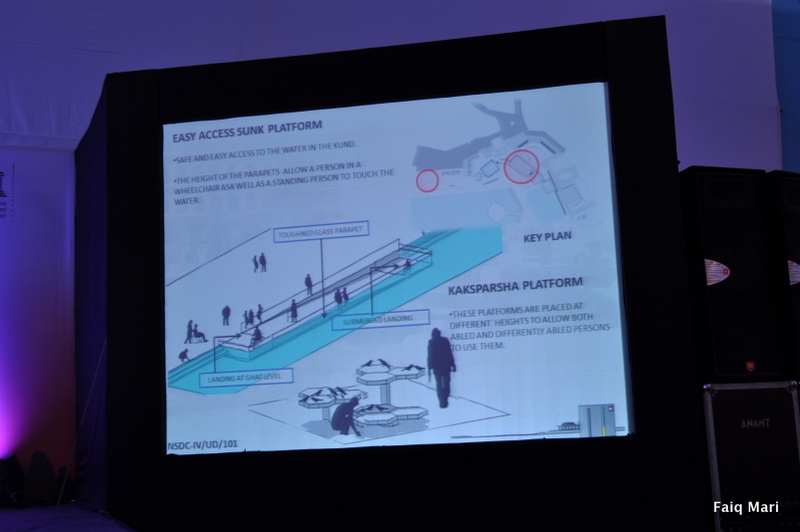 |
Details of one participating project
|
In general, the atmosphere was very inspirational and stimulating. I could only imagine the amount of work put into the projects submitted -over 170- and the dedication of the faculty who supervised the work of their students. More importantly, one could only appreciate the amount of knowledge developed amongst this large pool of architects and architecture students (given that the competition is an annual national event). The words of the speakers at the NSDC and of the judging panel we distinctly enlightening and the discussions that we indulged in later were very constructive.
 |
Professor Abir Mullick (foreground) and Professor A.G.K. Menon
(background): the judging panel at the NSDC.
|
I highly admired the socially responsible approach of SPA Bhopal. I could see that it is the fundamental outlook there to link architecture with the social challenges of its context and to shoulder the responsibility to handle them. The Center for Human Centric Research (CHCR), housed by SPA Bhopal, is a research center that reflects this line of action.
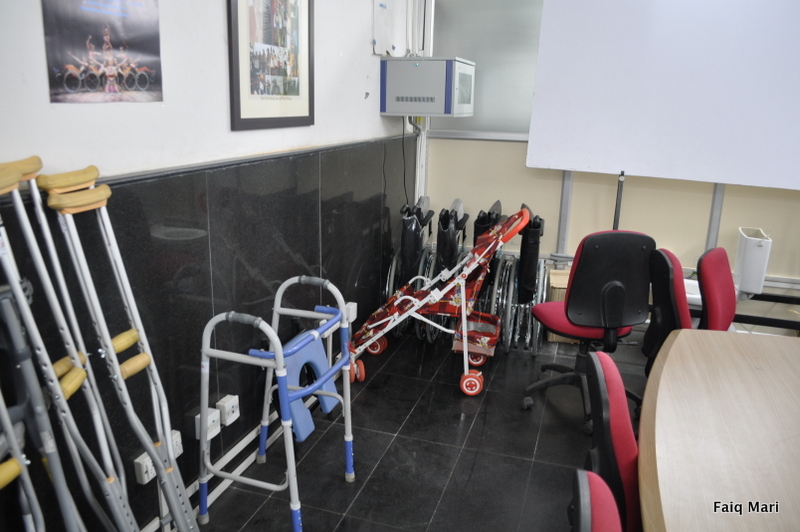 |
Simulation tools at the CHCR, SPA Bhopal
|
In the days following the competition I was able to learn more about the SPA and the CHCR. I got a better idea about the teaching methods and techniques utilized and was able to meet with students participating in the BERKELEY PRIZE Teaching Fellowship Universal Design course at their studio and discuss their projects and their own reflections on their education. I was particularly fond of the one-to-one scaled models that the faculty developed as a tool for interactive learning. The two models (a kitchen and a bathroom) are built from perforated plywood panels and can be furnished in various arrangements, letting the students experiment with the fixtures by changing heights and positions to achieve the most comfortable set-up. Moreover, guest users of various age groups and backgrounds are invited for these experiments thus giving the students the chance to understand the needs and requirements of differently-abled people.
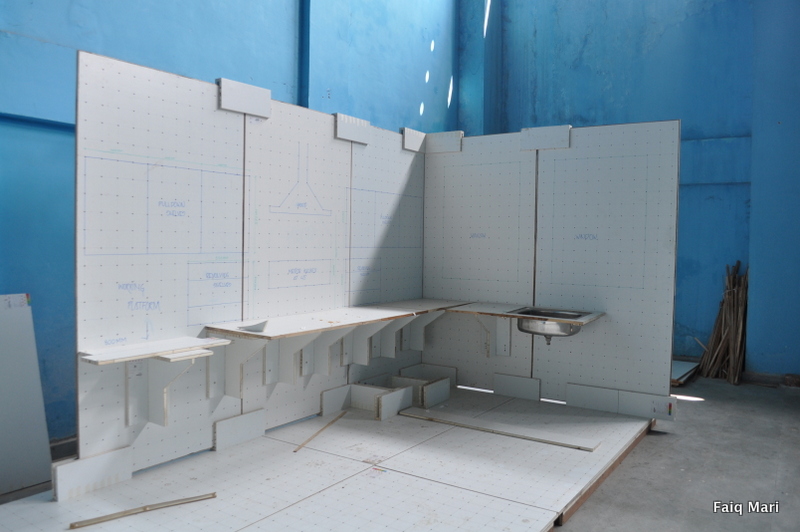
|
1:1 scaled model of a kitchen utilized for experimental education of design
|
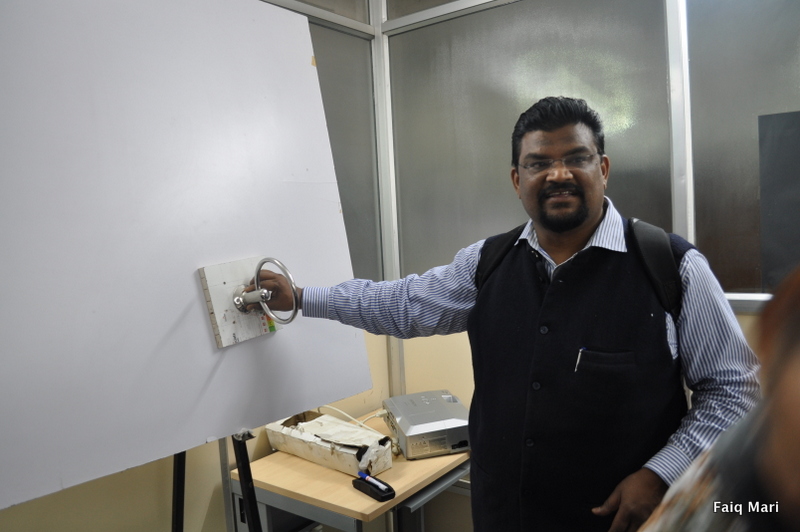
|
Professor Sandeep Sankat demonstrating the moveable fixtures concept, SPA Bhopal.
|
Later I delivered two presentations where I discussed my essay for the 2013 BERKELEY PRIZE competition and my current work in universal design education. The discussion was very constructive as it involved both students -many of whom study universal design, and several of them have applied to the BERKELEY PRIZE Essay Competition or are aiming to in the near future- and faculty, who are teaching Universal Design. Prior to the presentations I had shown a short film about my University, which gave a basic idea about my background.
Meanwhile, I met wonderful people, with whom I roamed the streets of Bhopal and visited the old city, many heritage sites and historical buildings, as well as modern masterpieces. I visited Ujjain, a pilgrimage city at which many of the projects in the competition were located, and where the faculty of the SPA supervises a number of projects. The spirit of the place was captivating.
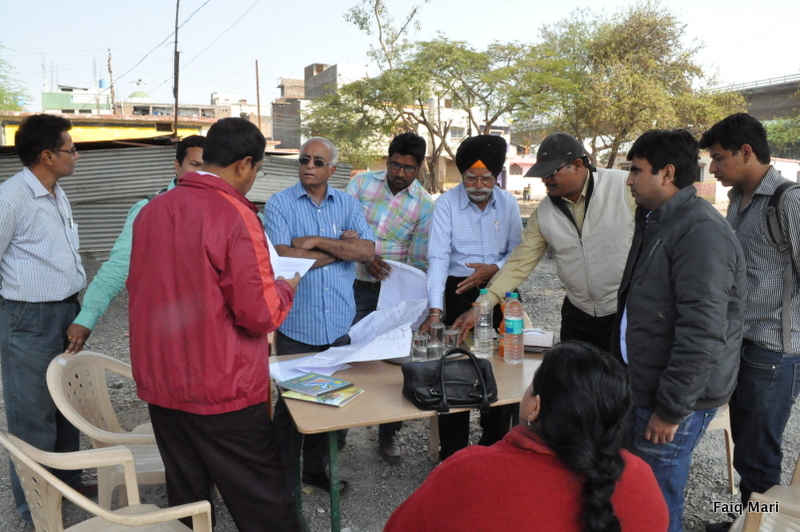 |
Site visit with the faculty of SPA Bhopal, at the city of Ujjain.
|
In my trip I felt a lot like home; I could relate to the people, the culture, the history, and the current and future challenges that many of us, peoples of the Global South, face. It was an immensely rich experience that I am looking forward to repeat.
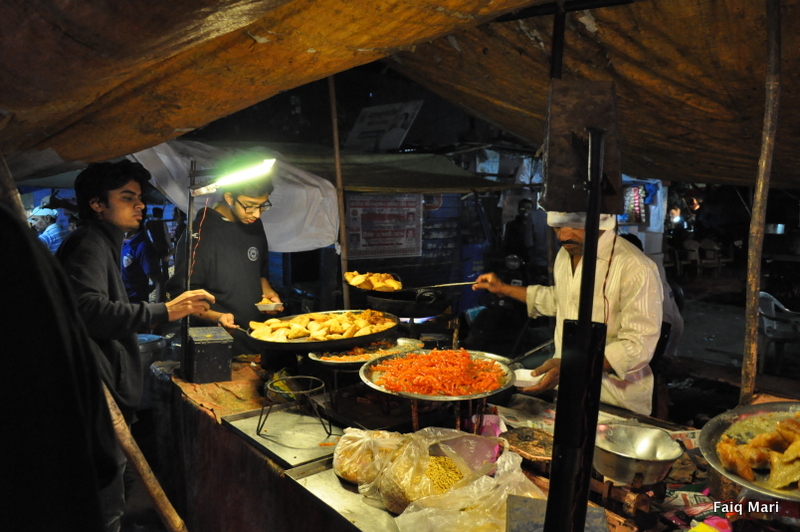 |
Eating Jalebi (Zalabia in Arabic) at the Wednesday Market, Bhopal.
|
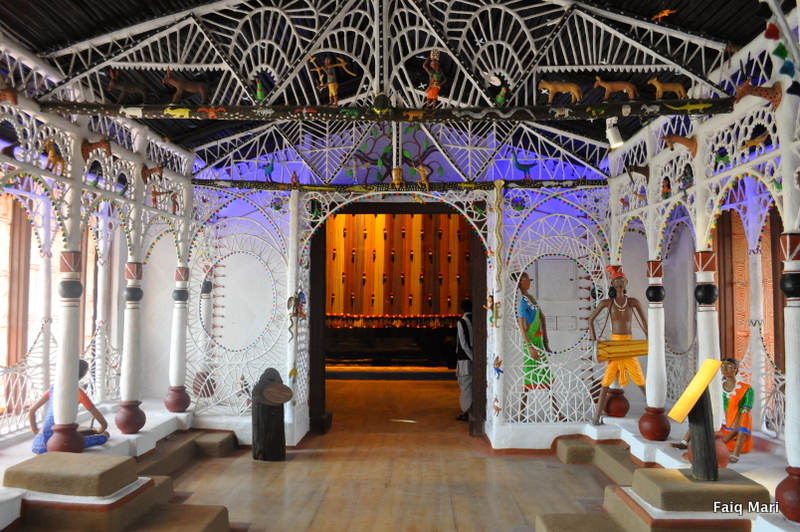 |
Tribal Museum, Bhopal.
|
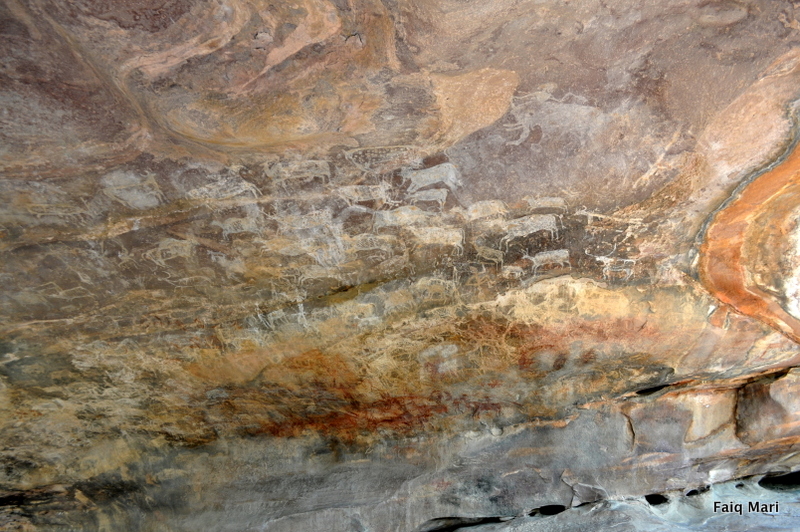 |
Paleolithic cave paintings at the Bhimbetka Rock Shelters, Bhimbetika.
|
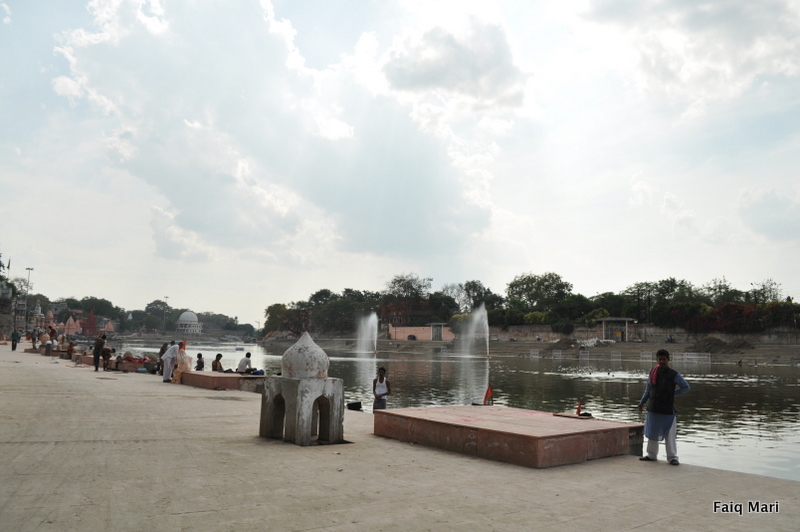 |
Holy riverfront, Ujjain.
|
 |
General view on Bhopal, the city of lakes.
|
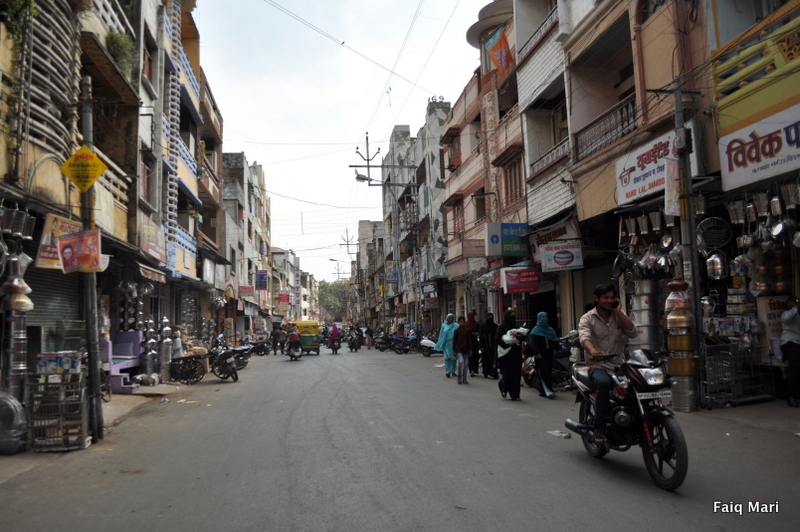 |
The streets of Ujjain. Madhya Pradesh, India.
|
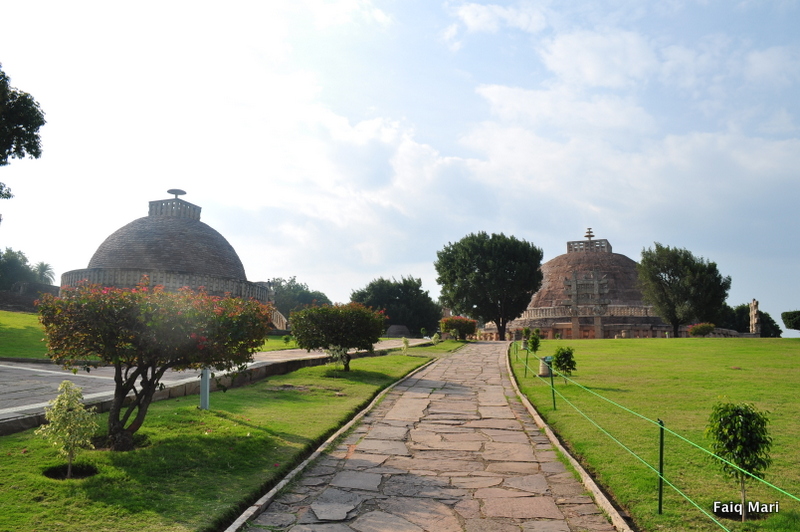 |
Sanchi Buddhist Stupas, Sanchi, Madhya Pradesh.
|
|
|
|
 Like everyone else, this worker in Mexico needs transportation to his job. Public transport needs to be accessible for persons with mobility, sensory, and cognitive disabilities.  Persons with disabilities around the world are promoting transport systems that provide mobility for everyone. Mexican disability advocates are shown meeting with local transit officials to promote accessible transport. AEI has published guides to assist planners and advocates of inclusive transportation.  An accessible travel chain begins with safe streets and sidewalks. This street in Foshan, China, has separate rights-of-way for pedestrians, human-powered vehicles, and motor-powered vehicles.  Disability advisors at Rio de Janeiro’s Independent Living Center monitored access features for this street crossing, part of the Rio City Project.  Tactile guideways and tactile warning strips assist blind and sight-impaired pedestrians as well as others in Foshan, China. 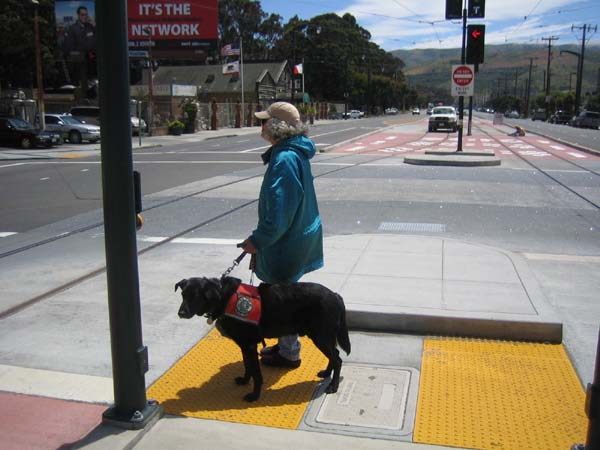 Tactile warnings alert this blind person crossing a mid-street island in San Francisco, USA. 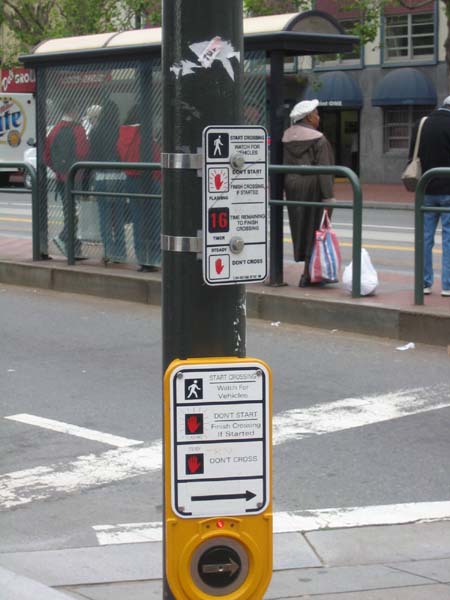 Busy intersections benefit from pedestrian controlled buttons and assist blind persons to cross through sound and vibration signals 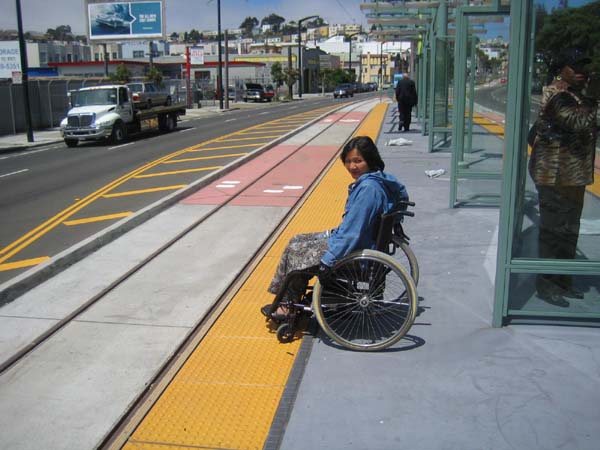 Tactile warnings protect blind persons – and all other passengers – from getting too close to the platform edge in transit stations. 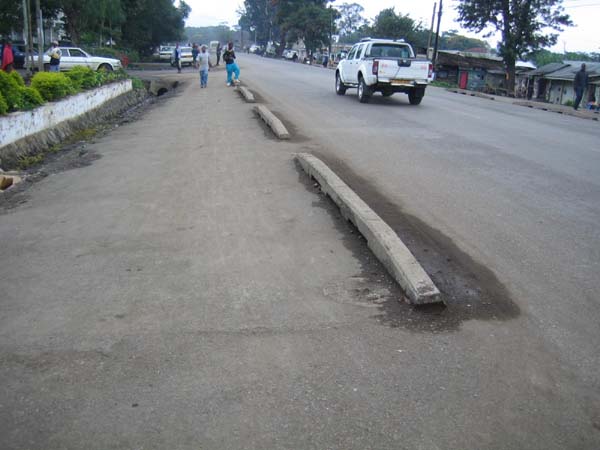 This footway adjacent to a road in Tanzania is protected by curb pieces which separate motor traffic from pedestrians and bicycles. Such basic safety measures are needed to prevent pedestrian injuries along roadways in many countries. 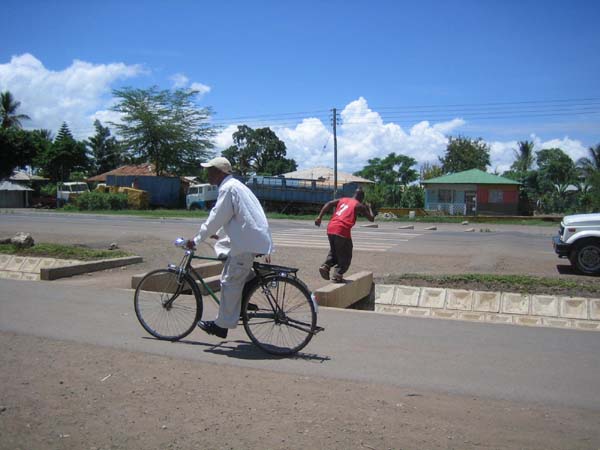 Even better, pedestrian and non-motorized traffic can be kept safely removed from motorized traffic by accessible sidewalks separated from the roadway, in this case by a well-designed drainage system along a main road in Tanzania. Speed bumps are used to slow traffic at crosswalks.  This pedestrian crosswalk provides level access to a bus island at an inter-modal transfer center in Mexico City.
Photo by T. Rickert, courtesy of DFID (UK) and TRL (UK).  Ticket vending machines should be low enough for use by wheelchair users and all short persons, as illustrated by the good design of this machine at a BART station in the San Francisco Bay area, USA.  Stairs are often retrofitted with stair lifts in transit terminals, as here in a Tokyo subway station. However, in new construction, elevators should be considered where possible.  A wheelchair user takes the elevator from the platform level of the Shenzhen, China, railroad station.  Wide doors are needed to accommodate wheelchair riders entering fare-paid areas of transit terminals, as in this subway station in Rio de Janeiro. 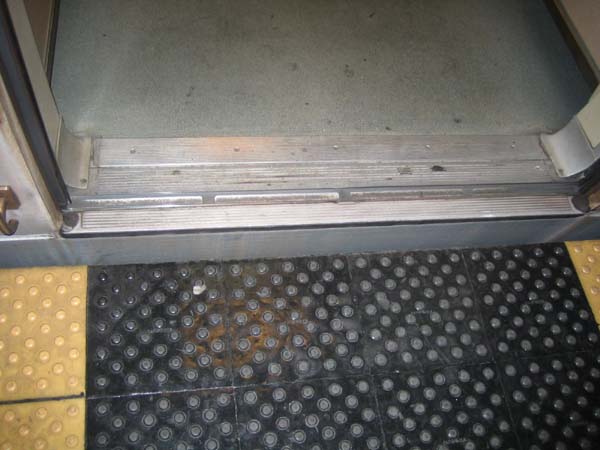 Everyone can safely board this BART train, due to a minimal horizontal and vertical gap. 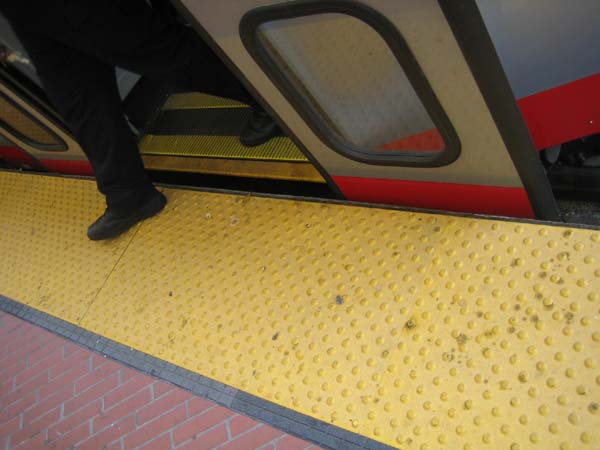 However, care must be taken that horizontal gaps are not too wide. The orange “gap filler” pops up when the doors open in San Francisco’s Muni Metro, assuring a safe gap.  Small portable ramps can provide inexpensive access in many rail stations, as shown here in Tokyo. 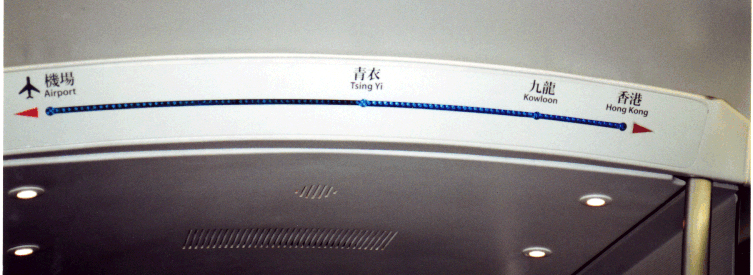 All passengers, and especially deaf and hard-of-hearing passengers, benefit from well-located visual information, as with this route display on board a train to the Hong Kong airport. 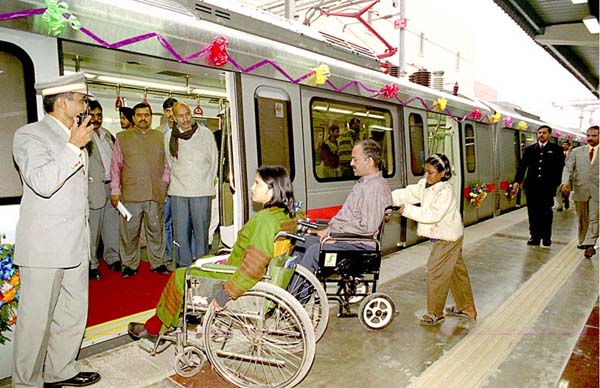 Advocates Anjlee Agarwal (left) and Sanjeev Sachdeva board the accessible Delhi Metro on its inaugural run.
Photo courtesy of Sanjay Sakaria and Samarthya, from Amar Ujjala Indian Daily  Express buses in Curitiba, Brazil, exemplify universal design. All passengers, including those with disabilities, quickly board with level entry. Similar Bus Rapid Transit (BRT) systems operate in Quito, Ecuador; Bogota, Colombia, and a growing number of cities around the world.
Photo by Charles Wright, Inter-American Development Bank. 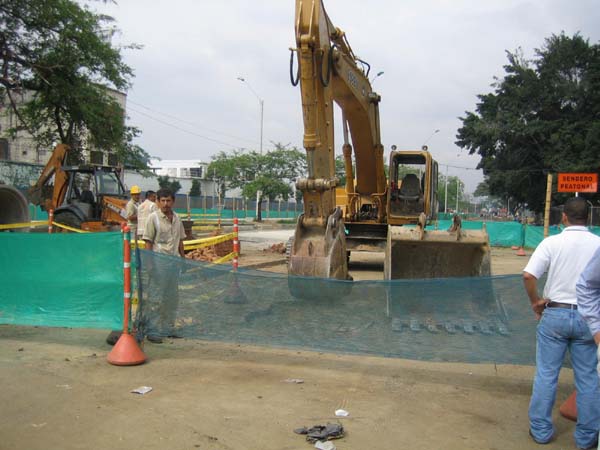 Construction of this Bus Rapid Transit (BRT) trunk line corridor in Pereira, Colombia, symbolizes the rapid spread of BRT systems around the world. BRT systems lend themselves to universal design, but details must be monitored carefully to maximize accessibility. 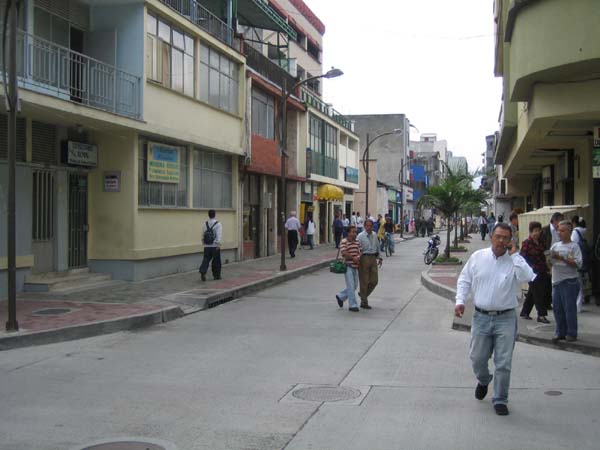 Although most BRT busways are on broad thoroughfares, this exclusive single-direction bus lane nearing completion in Pereira illustrates that BRT systems can sometimes be built on narrow streets.
This and above photo by T. Rickert courtesy of World Bank  The photo shows an articulated bus docking at a Bus Rapid Transit station in León, Mexico. 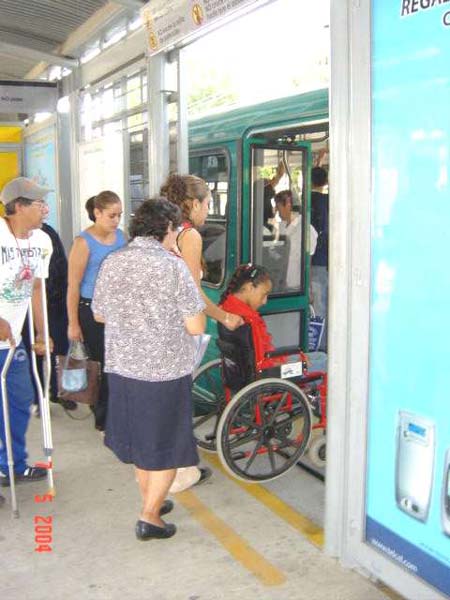 Pre-paid passengers inside a station board a high-capacity BRT bus in León.
This and above photo courtesy of Sistema Integrado de Transporte Masivo de León 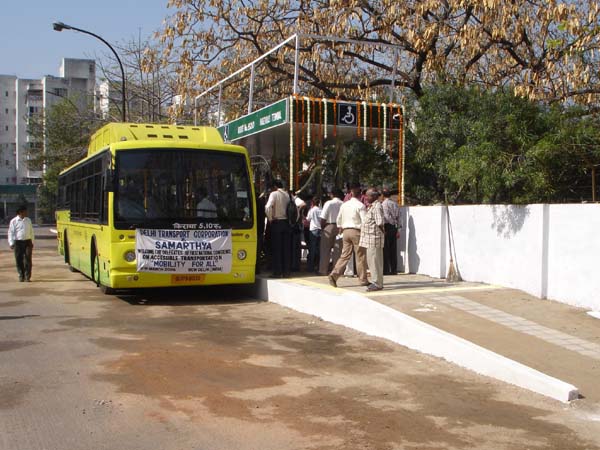 A prototype low-floor bus is tested in New Delhi adjacent to a platform the same height as the bus floor. 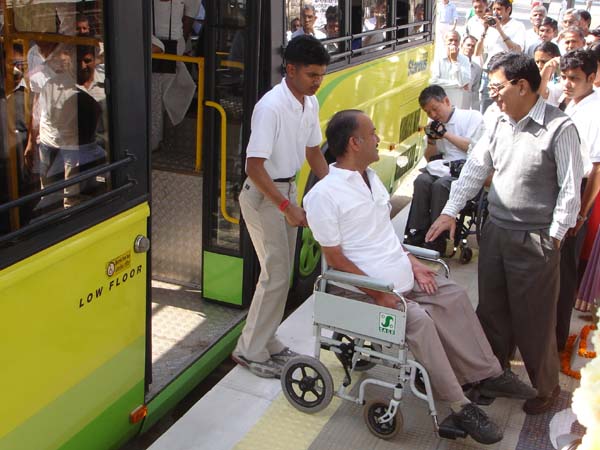 A closeup of the same bus stop illustrates the advantages of fast boarding for all passengers from platforms that eliminate the need for climbing steps to board.
This and above photo courtesy of Gerhard Menckhoff of the World Bank. 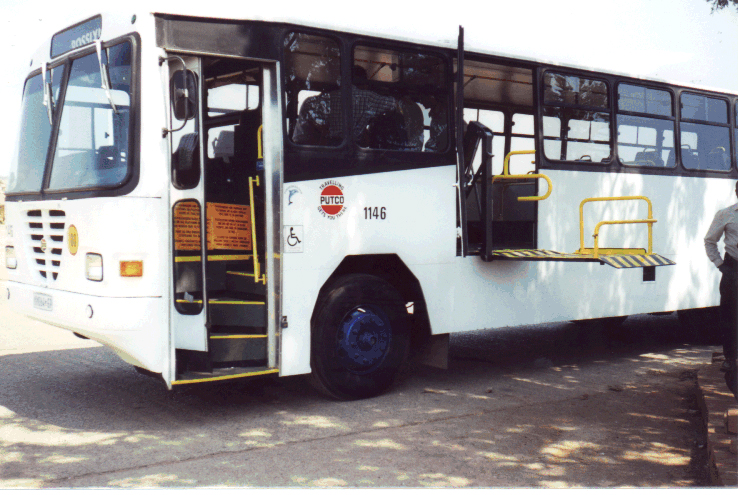 This prototype lift-equipped bus serves Mamelodi Township in South Africa. Note the excellent use of contrasting colors.
Photo by T. Rickert, courtesy of DFID (UK) and TRL (UK).  Mexico City officials inaugurated service in 2001 with 50 new buses equipped with lifts and other access features.
Photo courtesy of Marìa Eugenia Antunez.  In addition to a wheelchair lift, this bus in Mexico City has a retractable step beneath the front entrance.  This low-floor bus in Warsaw, Poland, uses an inexpensive hinged ramp which provides easy boarding for passengers with disabilities.  A low-floor bus in Hong Kong also exhibits excellent color contrast, using a bright yellow on key edges and surfaces. 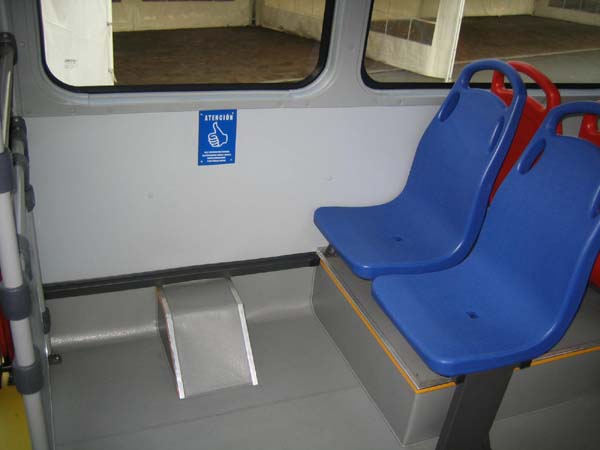 Transit systems around the world have reserved seating for seniors and passengers with disabilities, and often for pregnant women as well, as found on this TransMilenio bus in Bogotá, Colombia. 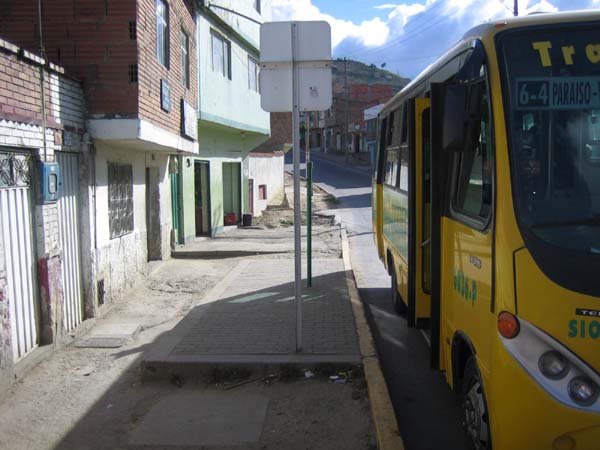 Even when bus stops are not accessible to wheelchair users, access for seniors and others with disabilities can be enhanced by a level all-weather pad even in the absence of paved sidewalks. The photo is from a TransMilenio feeder route in Bogotá.
This and above photo by T. Rickert courtesy of World Bank.  Thousands of Mexico City’s small inaccessible microbuses are being recycled and replaced with larger vehicles, often with better access features.  One such feature is this priority seating located behind the driver where there is extra leg room and it is easier for blind passengers to hear the driver call out key stops.
Photo by T. Rickert, courtesy of DFID (UK) and TRL (UK).  In other new buses in Mexico City, a wide rear door has low steps and is easily accessed by semi-ambulatory passengers from a raised sidewalk, but requires that drivers carefully pull in to the curb.
Photo by T. Rickert, courtesy of DFID (UK) and TRL (UK). 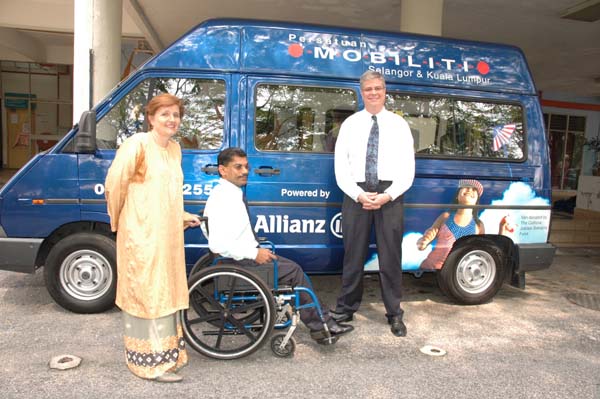 Community initiatives are playing a growing role in providing accessible door-to-door transport in many countries. This accessible van in Kuala Lumpur, Malaysia, belongs to the six-vehicle fleet of Persatuan Mobiliti.
Photo courtesy of Persatuan Mobiliti  Artist’s conception of a three-wheeled door-to-door vehicle connecting with an accessible ramped platform with bridge at a bus stop at a key site.  This prototype three-wheeled vehicle was built with AEI’s assistance by Kepha Motorbikes in Nairobi, Kenya.  Detail showing entry via a ramp at the rear of the test vehicle.
This and above photo courtesy of Wycliffe Kepha.  This accessible bicycle rickshaw in India has a rear door which serves as a ramp.
Photo courtesy of Bikash Bharati Welfare Society and Lalita Sen.  A public meeting in Cali, Colombia, discusses accessibility to Bus Rapid Transit systems. Readers can go to the Bus Rapid Transit Accessibility Guidelines in our Resources section, under the links to the World Bank.
Photo by T. Rickert, courtesy of the World Bank. 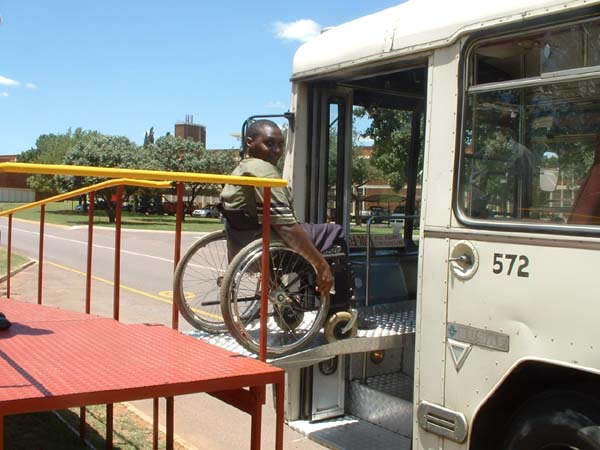 In this version, the bridge piece is mounted under the platform and put into place by the bus driver.
This and above photo courtesy of DFID (UK) and CSIR Transportek (South Africa). 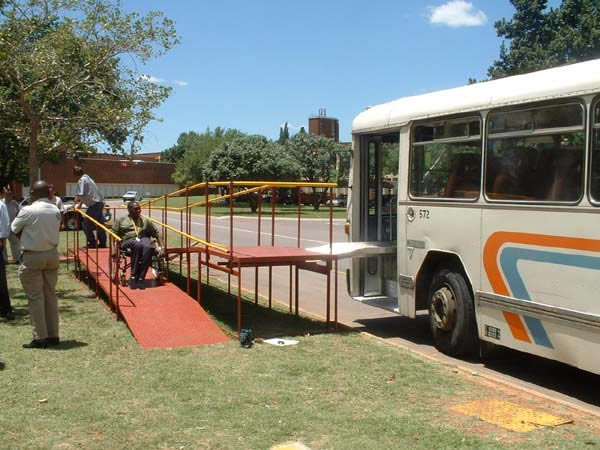 This test in South Africa of a prototype platform for use at key sites shows an alternative approach to access for wheelchair users.
|
|



























































